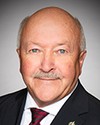Thank you, Mr. Chair, and thank you, committee members.
I'm joining you today from Vancouver International Airport, which is located on the traditional and unceded territory of the Musqueam Indian Band. Before I begin, I'd like to pay my respect to elders past and present.
I'm here today to represent the more than 20,000 workers that work at YVR every day.
Today, I offer the following recommendations on how government can support Canada's airports to the benefit of Canadian travellers and our economy. They are framed around: first, improving government processes and addressing regulatory barriers; second, the faster adoption of technology and innovation; and third, partnering with airports to accelerate investments that we are already making to evolve Canada's airports to next-generation economic engines.
Canada's airports are a dynamic ecosystem. We were an industry that expertly operated just-in-time supply chains that moved millions of bags, people and goods through our airports every day, so it has been difficult for our sector to experience the growing pains that we did over the past months.
Today, we're on a path to return to our prepandemic performance, and that is thanks in large part to our dedicated and fantastic workforce, our proactive planning and coordination with other partners and our relentless focus on innovation.
First, on the labour challenge, it's important to note that the airport proper at YVR is a certified living wage employer, and that means we pay our workers a fair wage for our region. In one case, that living wage policy helped us recruit more 80 new frontline workers this spring and have them on the floor in a matter of weeks. More than 600 people applied for those positions to work at YVR.
During the pandemic, we also accelerated our digital transformation and launched a new digital twin platform. This summer, we put that technology into the hands of those frontline workers, and that allowed them to monitor and deploy resources in real time to support travellers, airlines and government agencies when they needed it.
We also partnered with our Canadian airport colleagues and government agencies to quickly develop, test and deploy innovations. Those solutions are driving down wait times today, and they're reducing costs.
Of course, I would be remiss if I didn't mention the $150 million we will be spending over the next 10 years to become Canada's first net-zero airport by 2030.
How can government support us further?
On our first recommendation, YVR strongly encourages the federal government to remove the regulatory barriers that impede modernization of traveller security screen processes that are currently overseen by CATSA. The reality is that Canada's security screening regulatory structure is outdated and does not allow Canada to evolve to the risk-based approach to passenger security screening that we need today and that we see with our other G7 peer countries.
Specifically, rewriting the security screening measures is needed to start afresh. Importantly, the simplification of these regulations will create the operational flexibility our partners need to improve security throughputs, all without impacting the critical security function that frontline security screeners offer.
Furthermore, there is an urgent need for the Government of Canada to work with the U.S. government and reopen NEXUS enrolment centres in Canada. The NEXUS program has grown significantly over the past several years and is incredibly well subscribed by Canadians, yet today Canadians can't obtain a new NEXUS card, nor can they renew their existing enrolment.
On our second recommendation, YVR has clearly demonstrated how we can use data and digital solutions to improve our operational performance. In addition to launching our own digital twin platform, all of the airports in front of the committee today are collaborating in rolling out new innovations.
I'll draw your attention to the virtual queuing for security screening that Carmelle mentioned just a moment ago. That was piloted at Calgary International Airport and, as Carmelle mentioned, was a tremendous success. It's now going to be launched at all other large airports in Canada very shortly, and I'm proud to announce that YVR Express will be launching next week for our passengers.
There's an immediate opportunity for the federal government to join us to explore further innovations and deploy them quickly.
On our final recommendation, we are going to be living in a supply-constrained world for the next decade. As a result, we need to make significant joint investments in Canada's infrastructure.
At YVR, during the pandemic we identified the need to expand and enhance our cargo and logistics throughput, so we are actively putting $150 million of capital in place right now to expand YVR's air cargo operations, and that is for the benefit of Canadian cargo carriers. Importantly, this $150-million investment will facilitate more than $250 billion in domestic and international trade over the next 20 years. That's significant.
In partnership with airports, indigenous, and other non-government capital, we believe continued federal funding via programs such as the national trade corridors fund will help accelerate our investments.
In conclusion, we are meeting the challenges in front of us while also doing our part to keep air travel affordable and safe for Canadians. We appreciate the committee’s interest in exploring additional ways to reduce red tape and costs.
I look forward to taking your questions. Thank you.



